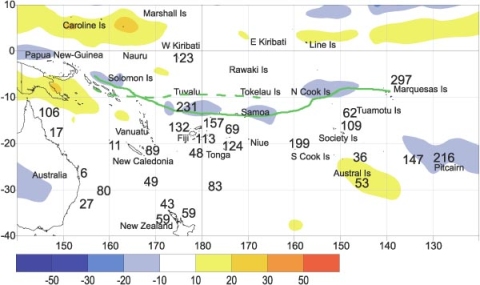Climate developments in July 2004
The SPCZ (South Pacific Convergence Zone) extended from the Solomon Islands to the region north of Fiji, and across Samoa to the Northern Cook Islands and the Marquesas Islands, with average or above average rainfall (more than 200% of normal on Rotuma Island) over much of its extent. High rainfall, exceeding 100 mm, occurred in parts of Fiji on 23 July. Enhanced convection and about 200% of average rainfall occurred over Pitcairn Island. Rainfall was also above average in parts of Western Kiribati, Fiji, northern Vanuatu, southern Tonga, and the Southern Cook Islands.
Suppressed convection occurred over Papua New Guinea, and rainfall was below average in New Caledonia, the Austral Islands, and notably so in parts of Queensland, Australia.
Mean air temperatures were at least 1.0°C above average in southern Tonga, and 0.5 to 0.9°C above average in Tuvalu. Temperatures were about 0.5°C below average in parts of Vanuatu, and 0.5 to 1.0°C below average in the Austral Islands.
Periods of surface westerlies occurred in the western equatorial Pacific for four weeks until 20 July, after which easterlies resumed. Tropical Southwest Pacific mean sea level pressures remained above average over Australia, and continued below average east of the Date Line from the Equator to southern French Polynesia, including Fiji and Tonga.
Climate extremes in July 2004
| Country | Location | Rainfall (mm) | % of average | Comments |
|---|---|---|---|---|
| Cook Islands | Rarotonga Airport | 207 | 199 | Well above normal |
| Fiji | Rotuma | 460 | 231 | Well above normal |
| French Polynesia | Hiva Hoa, Autona | 357 | 297 | Extremely high |
| Pitcairn Island | Pitcairn Island | 285 | 216 | Well above normal |
| Australia | Townsville Airport | 2 | 17 | Extremely low |
| Australia | Brisbane Airport | 4 | 6 | Extremely low |
| New Caledonia | Koumac | 6 | 11 | Extremely low |

